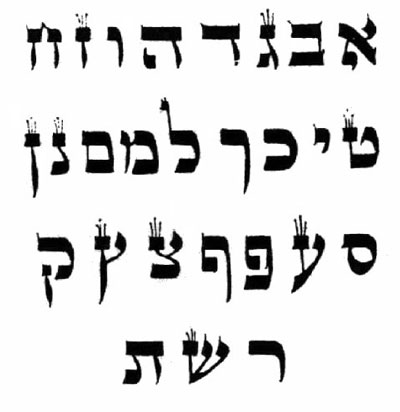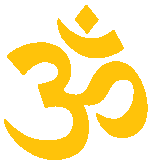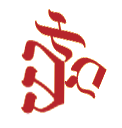Spirituality • Pedagogy • Philosophy • Movement

Spirituality • Pedagogy • Philosophy • Movement |

|
|
Hebrew Alphabet — AlefBeitNumber of Hebrew lettersAt the more obvious and literal level, there are of course precisely twenty-two letters of the Hebrew Alphabet, beginning with Alef (ℵ), and ending with Tav. It may be of interest that it is precisely the common opening (A) and the various endings of the three alphabets of the educated European from earlier times - namely the common (vulgar) Latin (A-Z), the philosophical-scientific Greek (A-O), and the spiritual Hebrew (A-T), that combined formed that most wonderful word 'AZΩTh'. Arranged sequentially in standard order, the Hebrew letters are:
I the above sequence, I have bolded the three mother letters and italicised the seven double letters. Each of these has three aspects of central importance also mentioned in the Sefer Yetzirah: their shape or image; their voiced sound; and their number value. Mother, Double, and Single lettersHebrew letters, in addition to also being used as numerals, have long been divided into three sections. Some of these divisions are made on linguistic grounds (or, rather, phonetic). For example, the letter Bet has two vocalisations, corresponding to our 'B' and 'V'. Both of these are bilabial — the sound arises from the two lips — one being plosive (B), the other fricative (V). There are seven such letters that have a plosive and fricative form (Cf green arrows below). One of these, Resh, tending to have 'lost' its plosive aspect. As its plosive form is used in the Tanakh (the Hebrew Old Testament), it nonetheless remains a sacred letter. Of the remaining letters, three have been designated mother letters (Cf red arrows below), reasons for which are only suggested by various exegesis (my own suggestion follows below). This leaves twelve letters to be deemed 'single'. Letters of the Hebrew Alphabet:
|
Shin • Lamed • Gimel
300 • 030 • 003 | Resh • Kaf • Beit
200 • 020 • 002 |
Kof • Yod • Alef
100 • 010 • 001 |
600 • 060 • 006 |
500 • 050 • 005 |
400 • 040 • 004 |
900 • 090 • 009 |
800 • 080 • 008 |
700 • 070 • 007 |
These two numerical methods can at times lead to some confusion. Is Kaf eleven or twenty? This is, however, in practise not as confusing as may at first appear. The value of the letter is in every case taken as its cardinal value (Kaf is 20), and its ordinal shows its (in this case eleventh) place or position relative the other letters.
 |
As for alphabets generally, a variety of fonts or type-faces exist. With Hebrew, sacred text such as the Torah are to be handwritten, with each letter following quite precise form. Admittedly, these developed over time, though based on both tradition and esoteric lore. The letters, written in black on white parchment, look approximately as shown on the left. Please note that letters that have a final form are included here, so if unfamiliar with the Alefbeit, compare these to the letters in the above section. Many of the letters, written in this manner, reflect the combination of two or more letters. I personally especially find this form appealing when looking at possible iconic similarities between a letter and a tarot trump — which I also show on the Noblet page. |
One of the absolute delights in working with the letters is in carefully observing their action within the human body. Here I would also recommend that some work be done with Eurythmy, for the results can be astounding.
With simply the mother letters, what one observes is that it begins with the opening of the throat (Alef as about to sound forth), vibrates through the whole cavity of the mouth until one closes the lips and allows the bilabial to alter the sound from oral cavity to nasal (Mem), ready for the new influx of spirit to re-enter the lungs with an inhaling (Shin). This process perculates through the whole alefbeit (Hebrew alphabet), and is reminiscent of the 'OM' (or AUM) sound of creation.


Rabbi Yitzchak Ginsburgh The Alef Beit: Jewish Thought Revealed through the Hebrew Letters